Adaptive Energy Management in 5G Network Slicing: Requirements, Architecture, and Strategies
Abstract
1. Introduction
1.1. Background and Motivation
1.2. Paper Overview and Contributions
- An architecture proposal that, based on NFV, SDN, and IoT technologies, is able to adaptively manage the available energy, whether 100% renewable or not, in the context of network slicing
- Several management strategies for adaptive energy consumption at the service level, including intra-slice service prioritization, service rejection, time shifting for service execution, and service quality degradation
- The mathematical model of the stakeholders involved in energy management and consumption
- The ILP formulation corresponding to the adaptive energy management model
- The performance metrics needed to confirm the improvements in energy consumption achieved with the proposed approach
- An exact algorithmic strategy denoted as and its evaluation through extensive simulations to verify the effectiveness of the proposed solution as well as the improvements in terms of energy consumption and service processing
- Discussion of several heuristics solutions to tackle the complexity of the optimal solution
2. Related Work
2.1. Energy Efficiency and Energy Management in 5G Networks
2.2. Use of Network Slicing Architecture for Resource Management
3. Energy Management Proposal for 5G Network Slicing
3.1. Requirements for the Energy Management in 5G Network Slicing
3.2. Energy Management Strategies for Adaptive Consumption
3.2.1. Prioritization of Services in Network Slices
3.2.2. Use of Time Shifting Capability for Service Execution
3.2.3. Degradation in Service Quality
3.2.4. Normal Processing of Services
3.2.5. Service Rejection
3.3. Architecture for Adaptive Energy Management
3.3.1. Architecture Description and Operation
3.3.2. Customers (Network Slices) Modeling
3.3.3. Mobile Network Operator (MNO) Modeling
4. Energy Management Model Mathematical Formulation
4.1. Assumptions Related to the Energy Management Model
- Use of a discrete-time model, in which the time horizon () is divided into slots of equal duration. This time model provides flexibility to energy management solution because the size of each time slot can represent different time units (e.g., a time slot equal to 10 min, or a time slot equal to 1 h) according to the applicability scenario.
- Use of a finite and discrete-time window for performing the time shifting (forward and backward) for the service execution. In this regard, in a preliminary study [19], we proved that the use small time shifting intervals (e.g., intervals up to two or three time slots) is enough to achieve considerable improvements in energy use (e.g., 100% energy utilization and improved service processing). In addition, a small time shifting interval is preferred because increasing this parameter produces a non-polynomial increase in the complexity of the optimal energy management problem, as demonstrated in [19].
- Use of discrete values for service quality degradation. To provide a feasible energy management model and maintain the linear condition of the problem, in the proposal, the values of degradation, also called levels of degradation that can be applied to a service, are restricted to a finite set of possibilities. Analogously to the time shifting value, this sequence of values should be small (e.g., up to three or four degradation levels) because an increase in levels corresponds to a non-linear increase in the complexity associated with optimal energy management.
- The proposed energy management model assumes the processing of entire (complete) services. If is insufficient to meet the total power demanded by a service, this service in analysis is considered as not processed or rejected. In this regard, the partial processing of a service and related consumption can be discussed in future work.
- In 5G network slicing, a customer (user equipment) may be served by at most eight network slices at a time [1]. However, in our proposal for simplicity, a customer can only belong to one network slice. Moreover, the customers in each network slice are different from each other (i.e., different network slices specified to different customers).
- If needed, the MNO can deploy multiple network slices of the same slice/service type (e.g., eMBB with the same features but for different groups of customers). In this case, the MNO is able to differentiate the slices according to the network slice identifier, as shown in the example in Figure 1a.
4.2. ILP Problem Formulation: OptTsNS
4.2.1. Objective Function
4.2.2. Constraints
- Domain constraints: The energy supply by the MNO for service processing is assured by . Instead, guarantees a non-negative difference between the power demanded and power provisioning. In Constraints , , and , the power variables are specified at time slot t, because the energy provisioning and consumption may vary at each time slot. Thus, the objective of the proposed model is the minimization of power consumption (from non-renewable sources) during all time slots within a finite time horizon W.
- Capacity Constraint: In the mobile communication system, the maximum energy capacity is limited by , in which the decision variable stands for the allocation of energy resources for the processing of the service , as shown in Equation (15).The correspondence between the service, its priority level, and the network slice to which it belongs is validated by Equation (16).
- Time constraints: and ensure a non-negative starting time for the entire system (). guarantees a finite time horizon for the analysis of services. The linear condition of the objective function, the constraints, and the decision variable deliver the linear nature to the problem.
4.2.3. Adaptive Management of Network Slices and Services
4.3. Hardness of the Problem
5. Evaluation
5.1. Metrics
- Acceptance Ratio (): This metric measures the number of services that are processed. If is insufficient to meet all power demanded (), one or several services should be rejected () [19]. The can be expressed as:
- Available Energy Utilization (): This metric measures the amount of energy allocated to processed services respect to the total amount of available energy (, if ). The can be defined as:
- Missing Power (): This metric measures the amount of power needed to process all demands under the current conditions of the system (i.e., for a given value of and ). The can be expressed as:
5.2. Optimal Algorithmic Strategy:
- Variations per service : A variation of a service is the result of the application of a specific discrete time shifting value to the and/or the application of a specific quality degradation level to the of a service . The analysis of all N services for each value of time shifting and for each quality degradation level produces a total number of variations . Considering that, for simplicity, the time shifting forward and backward have the same value, this number is given by:
- Combinations of services and computation of cost functions: In the algorithmic strategy, the set of N different variations of services () is named as a combination of services (). Each has specific characteristics and requires a certain power level . The algorithmic strategy evaluates the cost functions for each . Regarding the metric, the algorithm prioritizes the execution of the highest priority services (with the highest priority level). If the services have the same priority level, the algorithm selects the set of services that produce an optimization in the consumption of available power (maximization of energy use). The combinatorial analysis of all delivers a total number of combinations of services , which is given by:The computation of combinations of services (variations) contributes largely to the growth of complexity of the problem. For instance, , , and produce over 10 billion combinations. If a computer is able to process one each millisecond, it would need over 2900 h to explore the complete search space.
- Sorting of combinations and selection of the best combination: In this step, a quicksort method is applied to all combinations, according to the descending value of . Then, the best combination (which is the first in the sorted list) is chosen. Finally, the energy is allocated to the services that can be processed, and the performance metrics are computed.
5.2.1. Complexity Analysis of
5.3. Numerical Results
5.3.1. Simulation Setting
5.3.2. Case Study
5.3.3. Results and Discussion
6. Heuristic Strategies Discussion
7. Conclusions
Author Contributions
Funding
Acknowledgments
Conflicts of Interest
References
- System Architecture for the 5G System (5GS); Version 16.4.0; Technical Specification (TS) 23.501; 3rd Generation Partnership Project (3GPP): Sophia Antipolis, France, 2020.
- Service Requirements for the 5G System; Version 17.2.0; Technical Specification (TS) 22.261; 3rd Generation Partnership Project (3GPP): Sophia Antipolis, France, 2020.
- Management and Orchestration; Concepts, Use Cases and Requirements; Version 16.1.0; Technical Specification (TS) 28.530; 3rd Generation Partnership Project (3GPP): Sophia Antipolis, France, 2019.
- Management and Orchestration; Provisioning; Version 16.4.0; Technical Specification (TS) 28.531; 3rd Generation Partnership Project (3GPP): Sophia Antipolis, France, 2019.
- Report on Network Slicing Support with ETSI NFV Architecture Framework; Version 3.1.1; Technical Report (TR) GR NFV-EVE 012; European Telecommunications Standards Institute (ETSI): Sophia Antipolis, France, 2017.
- Study on Management and Orchestration of Network Slicing for Next Generation Network; Version 15.1.0; Technical Report (TR) 28.801; 3rd Generation Partnership Project (3GPP): Sophia Antipolis, France, 2018.
- Study on Tenancy Concept in 5G Networks and Network Slicing Management; Version 16.0.1; Technical Report (TR) 28.804; 3rd Generation Partnership Project (3GPP): Sophia Antipolis, France, 2019.
- Energy Efficiency of 5G; Version 1.3.0; Technical Specification (TS) 28.310; 3rd Generation Partnership Project (3GPP): Sophia Antipolis, France, 2020.
- Study on System and Functional Aspects of Energy Efficiency in 5G Networks; Version 16.1.0; Technical Report (TR) 32.972; 3rd Generation Partnership Project (3GPP): Sophia Antipolis, France, 2019.
- Sustainable Power-FeedingSolutions for 5G Networks; Version L.1210; Recommendation ITU-T L.1210; International Telecommunication Union (ITU): Geneva, Switzerland, 2019.
- GSMA. Energy Efficiency: An Overview. GSM Association. 2019. Available online: https://www.gsma.com/futurenetworks/wiki/energy-efficiency-2/ (accessed on 1 March 2020).
- Study on Methods and Metrics to Evaluate Energy Efficiency for Future 5G Systems; L.1310 Supplement 36; Recommendation ITU-T L.1310; International Telecommunication Union (ITU): Geneva, Switzerland, 2017.
- Wu, Q.; Li, G.Y.; Chen, W.; Ng, D.W.K.; Schober, R. An Overview of Sustainable Green 5G Networks. IEEE Wirel. Commun. 2017, 24, 72–80. [Google Scholar] [CrossRef]
- Standardization Terms and Trends in Energy Efficiency; L.1315; Recommendation ITU-T L.1315; International Telecommunication Union (ITU): Geneva, Switzerland, 2017.
- Assessment of Mobile Network Energy Efficiency; L.1331; Recommendation ITU-T L.1331; International Telecommunication Union (ITU): Geneva, Switzerland, 2017.
- Energy Control for the Software-Defined Networking Architecture; L.1360; Recommendation ITU-T L.1360; International Telecommunication Union (ITU): Geneva, Switzerland, 2016.
- Measurement Method for Energy Efficiency of Network Functions Virtualization; L.1361; Recommendation ITU-T L.1361; International Telecommunication Union (ITU): Geneva, Switzerland, 2018.
- Kreutz, D.; Ramos, F.M.; Verissimo, P.; Rothenberg, C.E.; Azodolmolky, S.; Uhlig, S. Software-defined networking: A comprehensive survey. Proc. IEEE 2015, 103, 14–76. [Google Scholar] [CrossRef]
- Tipantuña, C.; Hesselbach, X. NFV/SDN Enabled Architecture for Efficient Adaptive Management of Renewable and Non-renewable Energy. IEEE Open J. Commun. Soc. 2020. [Google Scholar] [CrossRef]
- Buzzi, S.; Chih-Lin, I.; Klein, T.E.; Poor, H.V.; Yang, C.; Zappone, A. A survey of energy-efficient techniques for 5G networks and challenges ahead. IEEE J. Sel. Areas Commun. 2016, 34, 697–709. [Google Scholar] [CrossRef]
- Renga, D.; Meo, M. From self-sustainable green mobile networks to enhanced interaction with the smart grid. In Proceedings of the 2018 30th International Teletraffic Congress (ITC 30), Vienna, Austria, 3–7 September 2018; Volume 1, pp. 129–134. [Google Scholar]
- Abdullaziz, O.I.; Capitani, M.; Casetti, C.E.; Chiasserini, C.F.; Chundrigar, S.B.; Landi, G.; Li, X.; Moscatelli, F.; Sakaguchi, K.; Talat, S.T. Energy monitoring and management in 5G integrated fronthaul and backhaul. In Proceedings of the 2017 European Conference on Networks and Communications (EuCNC), Oulu, Finland, 12–15 June 2017; pp. 1–6. [Google Scholar]
- Li, X.; Ferdous, R.; Chiasserini, C.F.; Casetti, C.E.; Moscatelli, F.; Landi, G.; Casellas, R.; Sakaguchi, K.; Chundrigar, S.B.; Vilalta, R.; et al. Novel Resource and Energy Management for 5G integrated backhaul/fronthaul (5G-Crosshaul). In Proceedings of the 2017 IEEE International Conference on Communications Workshops (ICC Workshops), Paris, France, 21–25 May 2017; pp. 778–784. [Google Scholar]
- Al-Quzweeni, A.N.; Lawey, A.Q.; Elgorashi, T.E.; Elmirghani, J.M. Optimized energy aware 5G network function virtualization. IEEE Access 2019, 7, 44939–44958. [Google Scholar] [CrossRef]
- Ren, Y.; Phung-Duc, T.; Chen, J.; Yu, Z. Dynamic Auto Scaling Algorithm (DASA) for 5G Mobile Networks. In Proceedings of the 2016 IEEE Global Communications Conference (GLOBECOM), Washington, DC, USA, 4–8 December 2016; pp. 1–6. [Google Scholar]
- Ren, Y.; Phung-Duc, T.; Liu, Y.; Chen, J.; Lin, Y. ASA: Adaptive VNF Scaling Algorithm for 5G Mobile Networks. In Proceedings of the 2018 IEEE 7th International Conference on Cloud Networking (CloudNet), Tokyo, Japan, 22–24 October 2018; pp. 1–4. [Google Scholar]
- Ordonez-Lucena, J.; Ameigeiras, P.; Lopez, D.; Ramos-Munoz, J.J.; Lorca, J.; Folgueira, J. Network slicing for 5G with SDN/NFV: Concepts, architectures, and challenges. IEEE Commun. Mag. 2017, 55, 80–87. [Google Scholar] [CrossRef]
- Hao, Y.; Tian, D.; Fortino, G.; Zhang, J.; Humar, I. Network slicing technology in a 5G wearable network. IEEE Commun. Stand. Mag. 2018, 2, 66–71. [Google Scholar] [CrossRef]
- Da Silva, G.; Oliveira, D.; Gomes, R.L.; Bittencourt, L.F.; Madeira, E.R.M. Reliable Network Slices based on Elastic Network Resource Demand. In Proceedings of the NOMS 2020—2020 IEEE/IFIP Network Operations and Management Symposium, Budapest, Hungary, 20–24 April 2020; pp. 1–9. [Google Scholar]
- Pozza, M.; Nicholson, P.K.; Lugones, D.F.; Rao, A.; Flinck, H.; Tarkoma, S. On Reconfiguring 5G Network Slices. IEEE J. Sel. Areas Commun. 2020, 38, 1542–1554. [Google Scholar] [CrossRef]
- Jiang, M.; Condoluci, M.; Mahmoodi, T. Network slicing management & prioritization in 5G mobile systems. In Proceedings of the 22th European Wireless Conference, Oulu, Finland, 18–20 May 2016; pp. 1–6. [Google Scholar]
- Xiao, Y.; Krunz, M. Dynamic network slicing for scalable fog computing systems with energy harvesting. IEEE J. Sel. Areas Commun. 2018, 36, 2640–2654. [Google Scholar] [CrossRef]
- Tipantuña, C.; Hesselbach, X. Demand-Response power management strategy using time shifting capabilities. In Proceedings of the Ninth International Conference on Future Energy Systems, New York, NY, USA, 12–15 June 2018; pp. 480–485. [Google Scholar]
- Generic Network Slice Template NG.116; Version 1.0; GSM Association: London, UK, 2019.
- Kellerer, H.; Pferschy, U.; Pisinger, D. Multidimensional knapsack problems. In Knapsack Problems; Springer: Berlin/Heidelberg, Germany, 2004; pp. 235–283. [Google Scholar]
- Vazirani, V.V. Approximation Algorithms; Springer Science & Business Media: Berlin/Heidelberg, Germany, 2013. [Google Scholar]
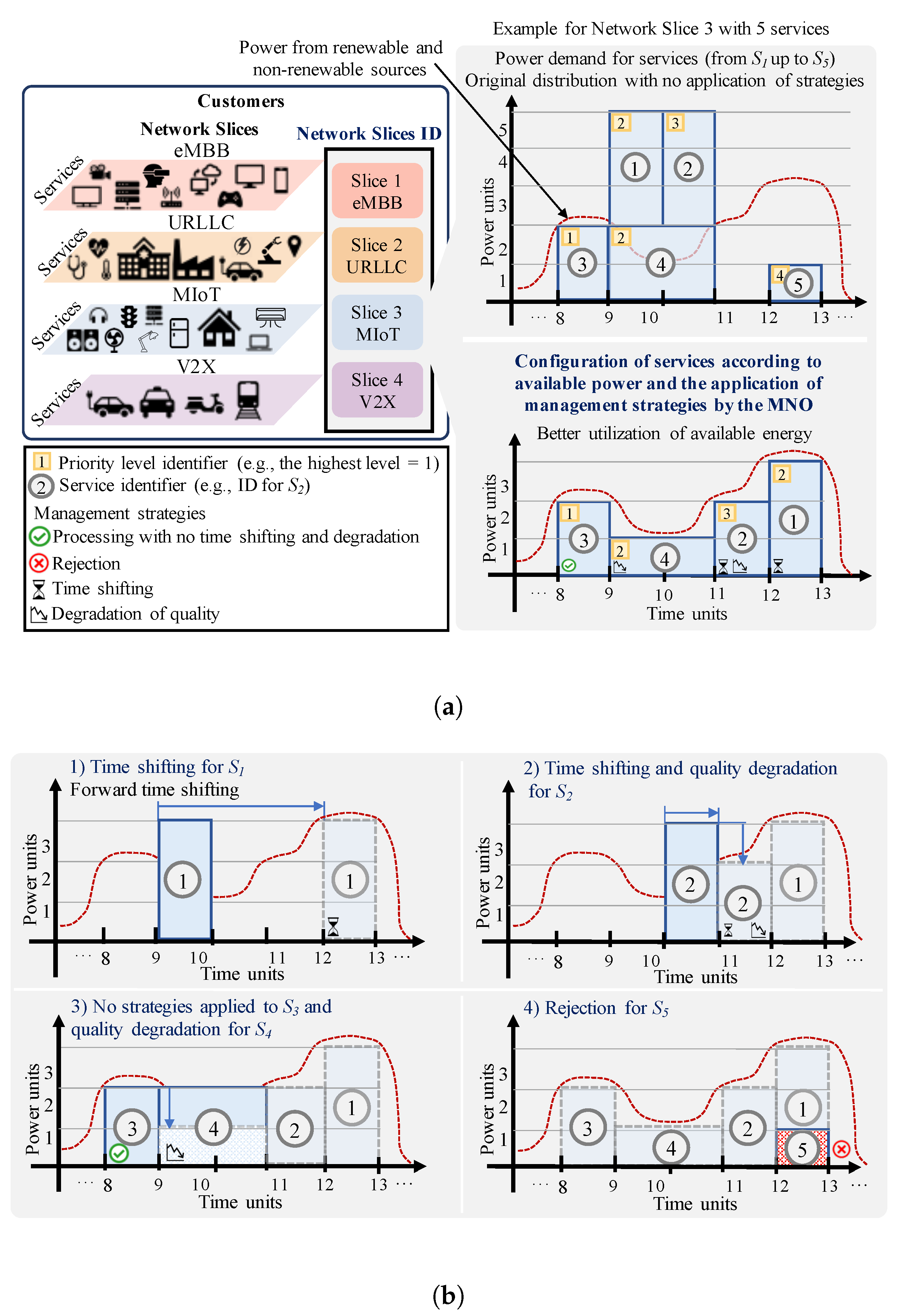


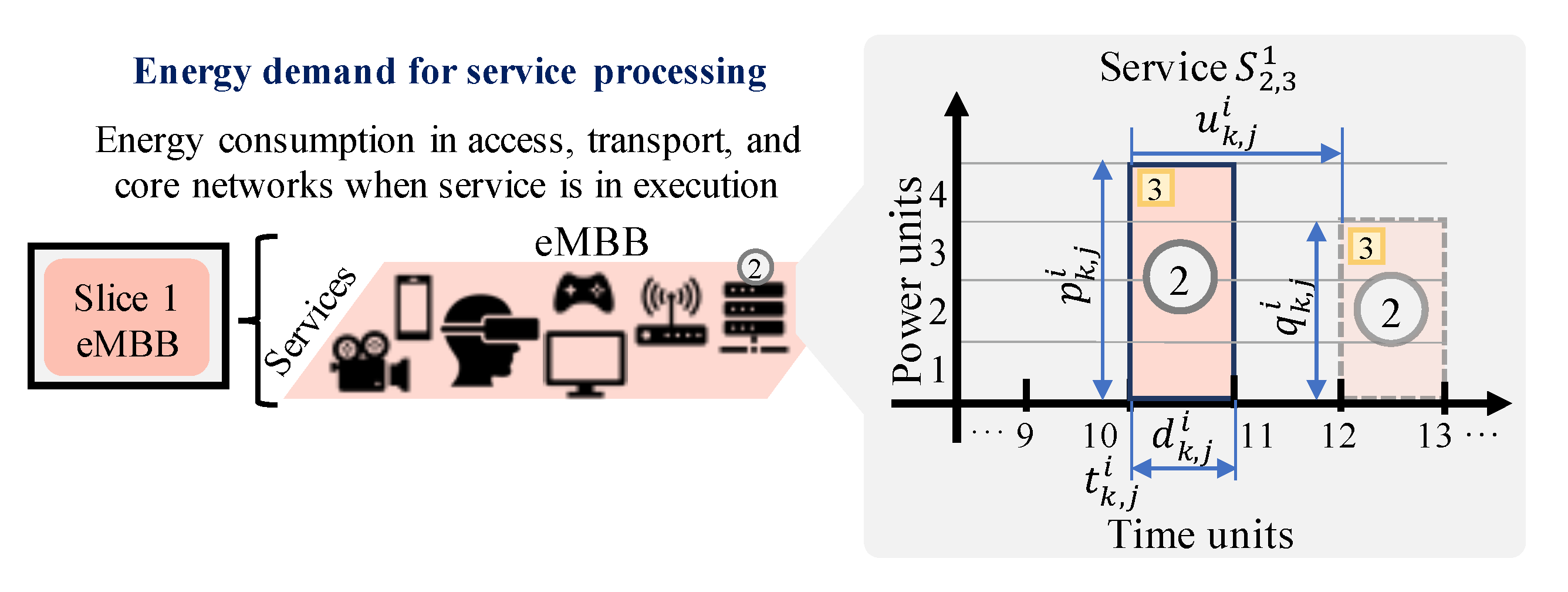

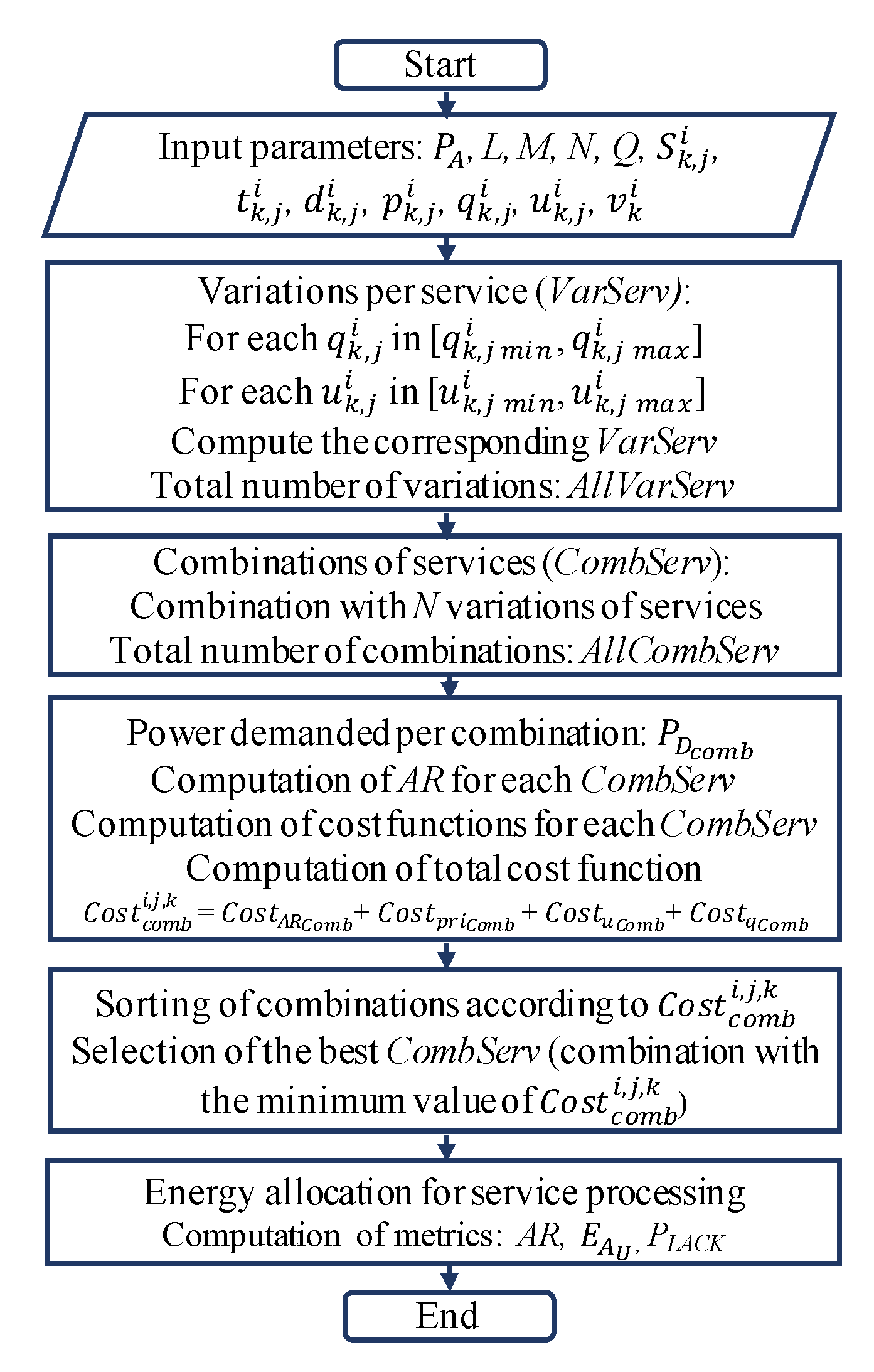
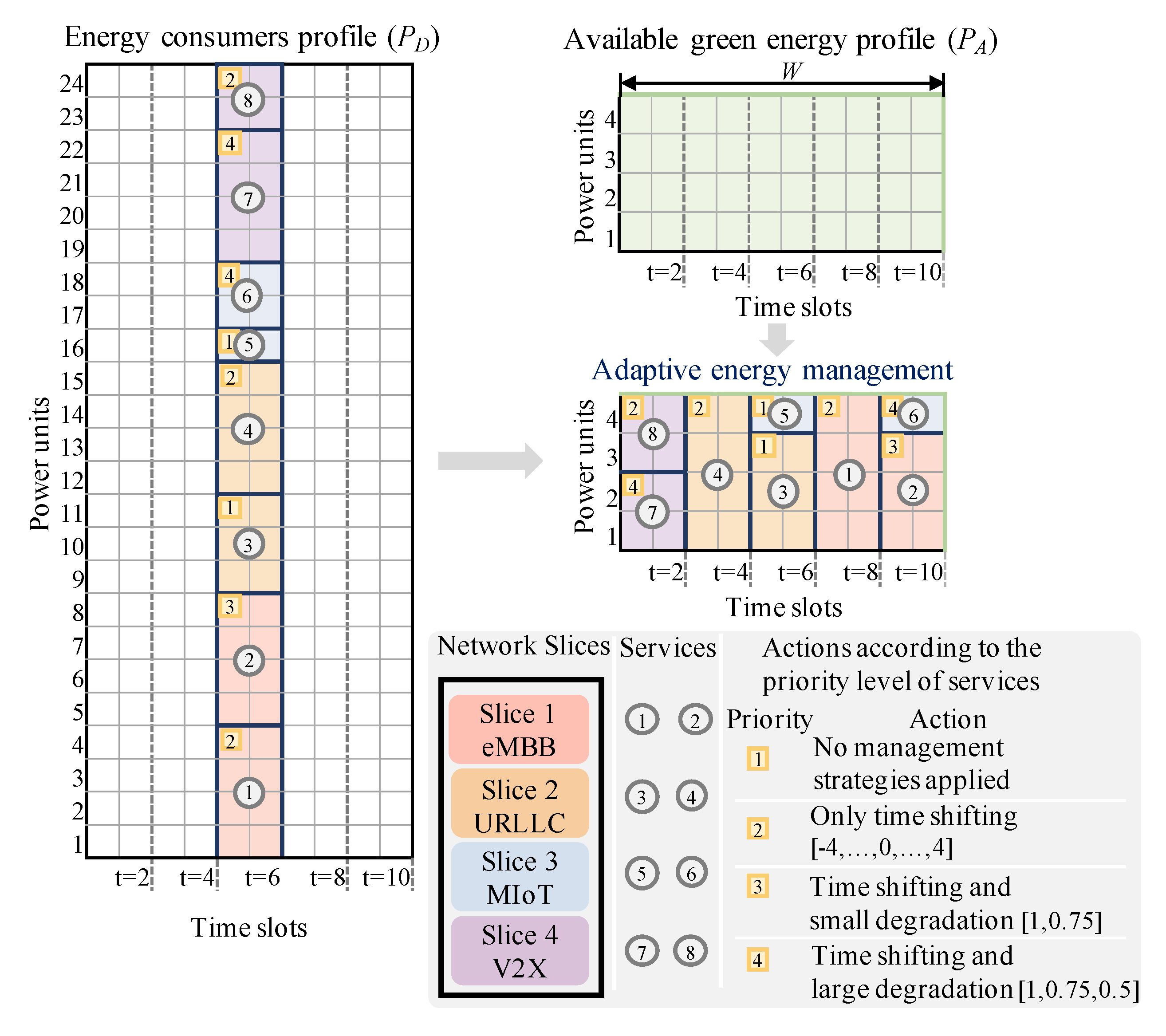
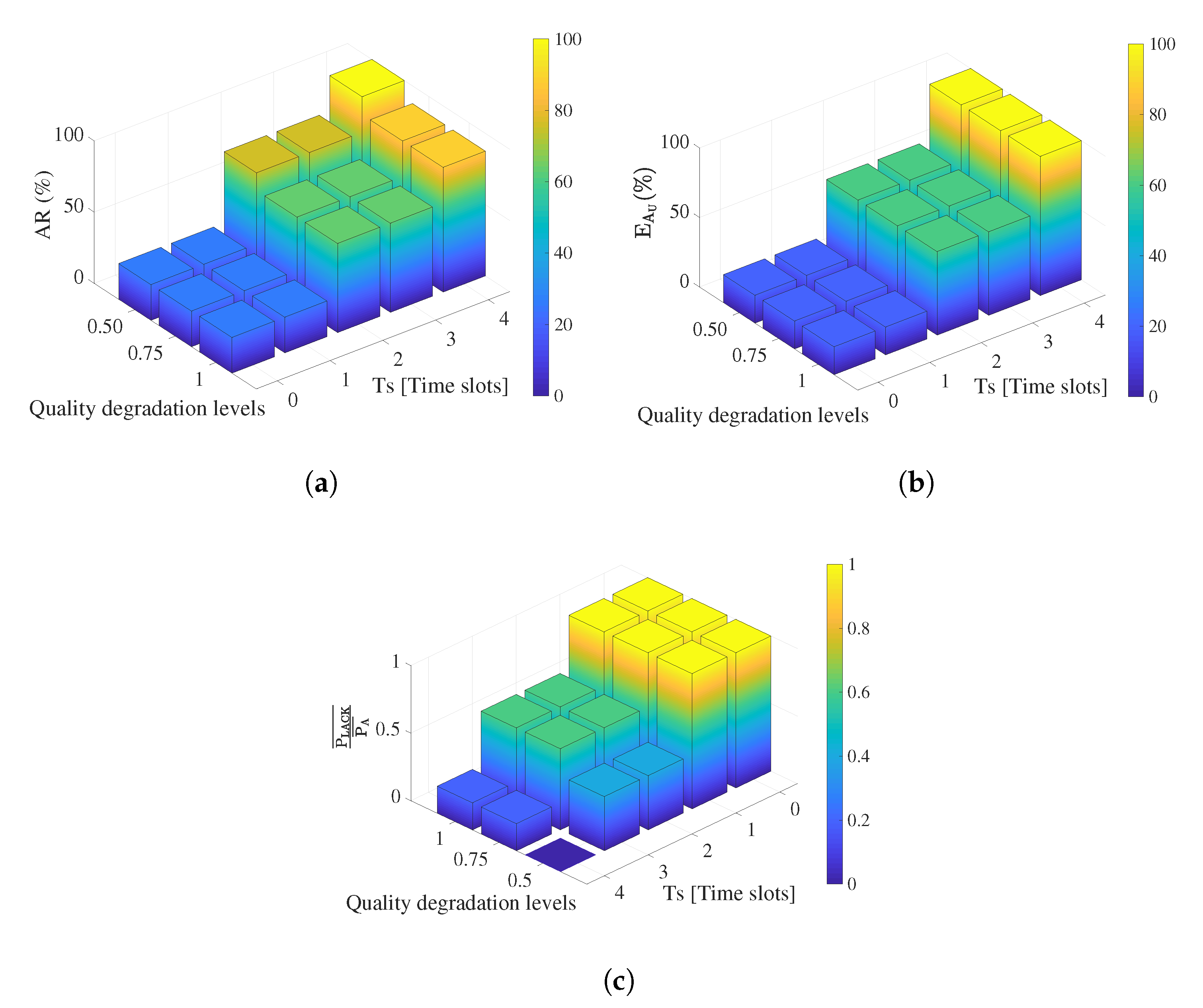
| Slice/Service Type | SST Value | Characteristics | Examples of Services |
|---|---|---|---|
| eMBB | 1 | Slice suitable for the handling of 5G enhanced Mobile Broadband | 4K/8K UHD, hologram, augmented/virtual reality |
| URLLC | 2 | Slice suitable for the handling of ultra reliable low latency (e.g., 1 ms) communications | High-accuracy positioning systems, motion control, autonomous driving, automated factory, smart-grid service, augmented/virtual reality |
| MIoT | 3 | Slice suitable for the handling of massive IoT | Sensor-network services (e.g., metering, agriculture, building, logistics, cite, home, etc.) |
| V2X | 4 | Slice suitable for the handling of V2X services | Vehicular communications systems (e.g., vehicle-to-vehicle, vehicle-to-infrastructure, etc.) |
| Acronym | Definition | Acronym | Definition |
|---|---|---|---|
| 3GPP | 3rd Generation Partnership Project | MNO | Mobile Network Operator |
| 5G | 5th Generation Mobile Network | NB-IoT | Narrow Band Internet of Things |
| eMBB | Enhanced Mobile Broadband | NFV | Network Functions Virtualization |
| ETSI | European Telecom. Standards Institute | NSI | Network Slice Instance |
| ICT | Infor. and Com. Technologies | OPEX | Operational Expenditures |
| ILP | Integer Linear Programming | SST | Slice/Service Type |
| IoT | Internet of Things | SDN | Software Defined Network |
| ITU | International Telecommunication Union | URLLC | Ultra Reliable Low Latency Com. |
| MANO | Management and Orchestration | V2X | Vehicle to X (e.g., Vehicle, Infrastructure) |
| mIoT | Massive IoT | VNF | Virtual Network Function |
| Area | Institution or Organization | Documentation | Description |
|---|---|---|---|
| Requirements and features of 5G | 3GPP | Technical specification TS 23.501, release 16 | System architecture for the 5G System [2] |
| Technical specification TS 22.261, release 17 | Service requirements for the 5G system [1] | ||
| Network Slicing | 3GPP | Technical specification TS 28.530, release 16 | Management and orchestration; Concepts, use cases, and requirements [3] |
| Technical specification TS 28.531, release 16 | Management and orchestration; Provisioning [4] | ||
| Technical report TR 28.801, release 15 | Study on management and orchestration of net. slicing for next generation network [6] | ||
| Technical report TR 28.804, release 16 | Study on tenancy concept in 5G networks and network slicing management [7] | ||
| ETSI | Technical report GR NFV-EVE 012 | Report on Network Slicing Support with ETSI NFV Architecture Framework [5] | |
| Energy efficiency, management, and renewable energy sources | 3GPP | Technical specification TS 28.310, release 16 | Energy efficiency of 5G [8] |
| Technical report TR 32.972, release 16 | Study on system and functional aspects of energy efficiency in 5G networks [9] | ||
| ITU-T | Recommendation L.1210 | Sustainable power-feeding solutions for 5G networks [10] | |
| Recommendation L.1310 | Study on methods and metrics to evaluate energy efficiency for future 5G systems [12] | ||
| Recommendation L.1315 | Standardization terms and trends in energy efficiency [14] | ||
| Recommendation L.1331 | Assessment of mobile network energy efficiency [15] | ||
| Recommendation L.1360 | Energy control for the software-defined networking architecture [16] | ||
| Recommendation L.1361 | Measurement method for energy efficiency of network functions virtualization [17] |
| Requirements | Related Technical Documentation | Proposed Solution | |
|---|---|---|---|
| ID | Description | ||
| R1 | Energy management for network slices and corresponding services throughout all components of the 5G system, in which the service processing is aware of energy supply with the aim of optimizing the consumption at all times. | 3GPP TS 23.501 3GPP TS 22.261 3GPP TS 28.310 ITU-T L.1331 | Adaptive energy management solution for 5G network slicing, in which the creation and configuration of networks slices is aware of the energy generation and consumption conditions. |
| R2 | Definition of priority order for services within a network slice in the case the available energy at a certain time is insufficient to meet all demand. Based on this level of priority, the MNO must be able to differentiate the access to the energy resource and the application of management strategies for each service. | 3GPP TS 22.261 3GPP TS 28.530 3GPP TS 28.531 3GPP TR 28.801 3GPP TR 28.804 ETSI NFV-EVE 012 | Prioritization scheme at service level (intra-slice priority scheme) for the energy allocation process. In the proposed architecture, the MNO decides the number of priority levels to implement and the assigned level to each service. The assignation of priority level can also be established through agreements with customers. |
| R3 | Use of software-based platforms and virtualization to facilitate the creation and managing of network slices, the configuration of network functions to implement energy management strategies, and the incorporation of features for serving new SST. | 3GPP TS 23.501 ITU-T L.1360 ITU-T L.1361 | Use of NFV and SDN technologies, to bring agility, flexibility, and reconfigurability to the proposal. |
| R4 | Use of energy from renewable energy sources, as a sustainable and environmentally friendly alternative for powering mobile networks, and control of its contribution to the total energy supply. | 3GPP TS 28.310 3GPP TR 32.972 ITU-T L 1210 | Promotion and prioritization of the use of green energy, and implementation adaptive energy management strategies (see Section 3.2) to leverage its dynamic and intermittent generation. |
| R5 | Energy management constrained to availability. The proposed energy management model must be able to automatically adapt the consumption (i.e., the configuration of network slices) to the energy capacity, producing no or minimal impact on the performance of network slices and corresponding services. | 3GPP TS 23.501 3GPP TS 22.261 TS 3GPP TS 28.310 | Implementation of strategies for adaptive energy consumption on network slices or services (see Section 3.2). In the proposed architecture, the customer is aware of the configuration of network slices and services (e.g., modification of execution time, the power demanded, or activation/deactivation state) performed by the MNO to optimize the energy consumption. |
| R6 | Implementation of mechanisms to achieve energy efficiency through optimization of energy use and reduction in consumption (i.e., energy saving). These mechanisms must be executed by the MNO and must produce no or minimal performance degradation for customers. Services belonging to network slices must be able to work in energy-saving states (e.g., low energy consumption) or postpone their execution (i.e., enter into sleep or idle mode) according to the availability. | 3GPP TS 22.261 3GPP TS 28.310 3GPP TR 32.972 ITU-T L.1310 ITU-T L.1315 ITU-T L.1331 | To offer an adaptive energy management solution that optimizes the use of energy resources and reduce consumption, the following management strategies for services are considered in the proposed management model: (i) degradation of service quality, which represents a decrease of consumption (i.e., low power consumption); (ii) rejection or non-execution of service(s) (i.e., deactivation of service); and (iii) application of time shifting (forward or backward) in the service execution time. |
| R7 | Definition of metrics or indicators to assess the energy efficiency achieved with the proposed energy management model. | 3GPP TR 32.972 ITU-T L.1310 ITU-T L.1315 | Definition of three performance metrics: (i) percentage of services processed; (ii) percentage of energy used by services processed; and (iii) amount of missing energy to process all services. |
| Parameter | Description | Unit/Comment |
|---|---|---|
| L | Number of network slices | Integer number |
| i | Network slice identifier | |
| M | Number of priority levels of services | Integer number |
| j | Priority level identifier | |
| N | Total number of services in the system | Integer number |
| k | Service identifier | |
| Q | Number of quality degradation levels | Integer number |
| Starting time of service | Time units | |
| Duration of service | Time units | |
| Power demanded of service | Power units | |
| Quality level of service | Discrete values (e.g., [, …, ]) | |
| Time shifting value of service | Time units (backward:, or forward: ) | |
| Priority level of service k belonging to network slice i | Integer number |
| Parameter | L | M | N | W | Q | |||||
| Value | 4 | 4 | 8 | 10 | 4 | 2 | 4, see Figure 7 | [1–4], see Figure 7 | 3 | [1, 0.75, 0.5], see Figure 7 |
| Strategy/Technique | General Description | Features and Challenges |
|---|---|---|
| Pre-Partitioning Strategy | Strategy based on a divide-and-conquer method. The original problem is divided into sub-problems of less complexity that are solved iteratively. The final solution is a combination of partial solutions. | - Easy implementation. Few modifications on are required. - The strategy can be seen as a generalization of . - The size of the search space decreases as divisions increase. - Control of the accuracy and running time based on the number of divisions. |
| Greedy Approach | Iterative and constructive algorithm, in which the to be processed, one at time, is selected based on the value of a parameter, e.g., , , or the ratio between and , respecting the and with the aim of first minimizing power consumption of and then increasing . | - Easy implementation. The strategy must be built from scratch and there are many possible implementations. - Good running time performance. However, there is no guarantee on the quality of the solution, because it can vary widely according to the parameter used to select the . |
| Genetic Algorithm | Strategy inspired in the behavior of biological systems. First, an initial population of chromosomes is created, where each chromosome represents a possible (solution) formed by randomly selected . Later, the population evolves along with generations considering the action of the genomic operators (crossover and mutation) and the selection of fittest individuals (combinations with the best performance metrics). Finally, in the last generation, the solution with the best fitness function (minimum ) is selected. | - Medium complexity implementation due to requirements of the proposal (time shifting, priorities, and rejection). - Nondeterministic solution. It depends on the random values chosen in the creation of populations (initial and offspring) and the selection of genetic operators (crossover and mutations). - Good running time performance. However, the final solution may require many generations if the parameters for population creation or stop criteria are not properly established. |
| Dynamic Programming Approach | Strategy that uses a dynamic programming method. The algorithm simplifies the analysis of N simultaneous services by analyzing and solving them one at a time. Systematically, using a bottom-up approach, the results of a previous set of services (considering their ) are stored and used for solving a greater number of services. | - Good running time performance, but difficult implementation due to the two-dimensional behavior of the problem (power and time parameters) and multiple-choice analysis for selection. |
© 2020 by the authors. Licensee MDPI, Basel, Switzerland. This article is an open access article distributed under the terms and conditions of the Creative Commons Attribution (CC BY) license (http://creativecommons.org/licenses/by/4.0/).
Share and Cite
Tipantuña, C.; Hesselbach, X. Adaptive Energy Management in 5G Network Slicing: Requirements, Architecture, and Strategies. Energies 2020, 13, 3984. https://doi.org/10.3390/en13153984
Tipantuña C, Hesselbach X. Adaptive Energy Management in 5G Network Slicing: Requirements, Architecture, and Strategies. Energies. 2020; 13(15):3984. https://doi.org/10.3390/en13153984
Chicago/Turabian StyleTipantuña, Christian, and Xavier Hesselbach. 2020. "Adaptive Energy Management in 5G Network Slicing: Requirements, Architecture, and Strategies" Energies 13, no. 15: 3984. https://doi.org/10.3390/en13153984
APA StyleTipantuña, C., & Hesselbach, X. (2020). Adaptive Energy Management in 5G Network Slicing: Requirements, Architecture, and Strategies. Energies, 13(15), 3984. https://doi.org/10.3390/en13153984






